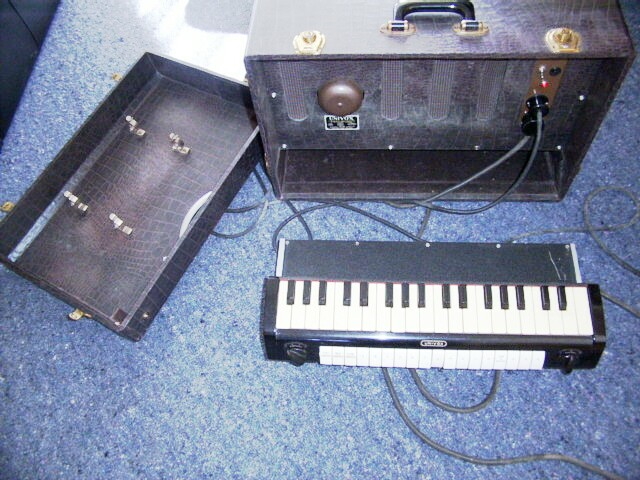Description
How rare is this. 1940’s/50’s Univox out England. Yes and it goes though in need of some enthusiastic maintenance. I have owned this for many years and I’m not the one with time or inclination. A valuable piece of kit open to offers. Hit my contact page.
Developed by the Jennings Organ Company,West Hill, Dartford (later Jennings Musical Industries; creators of the Vox range of organs and amplifiers) in the UK, the Univox was a monophonic, portable, piano attachment instrument similar to the Clavioline. It’s sound came from a vacuum-tube sawtooth generator (as opposed to the square wave of the Clavioline) which in turn was modulated by a diode waveform shaper circuit. The pitch range was extended to three octaves (five in later models) using a frequency division technique which also allowed the playing of multiple octaves of the same note from one key. The instrument was controlled by a three octave F to F miniature wooden keyboard and came with it’s own 6 watt amplifier and 8″ speaker all built into a leather carrying case;
Tom Jennings saw the market potential and already had a good slice of the keyboard sales for accordions etc. Tom found a local electronic engineer, Les. Hills, who studied the Clavioline and designed another circuit different to the existing French patent. Unfortunately the product was not at all reliable, with most units breaking down almost as soon as they got to the end customer. Some of this problem was due to instability in the earlier circuit design but mostly due to choice of suitable components and mechanical shortcomings.
In about 1951/1952 the Univox took off in a big way due to its competitive price and Tom’s country wide marketing program. The first version was the J6, single keyboard model, later followed by the J10 with two rows of Tone & effect tabs. All models were supplied with metal screw-on clips, to fasten it under the right hand side of a piano. Later we designed an adjustable chromed stand that enabled the user to do gigs in other locations with out having to screw on fixing brackets each time. Most customers in those days were either Pub owners or pianists playing Pub gigs.

